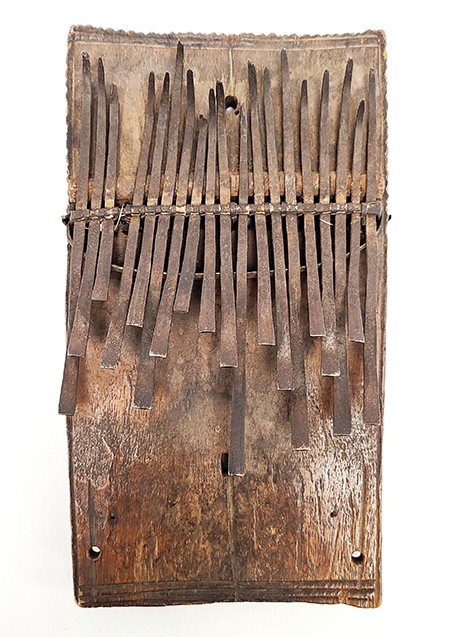Kuba Thumb Piano

Thumb pianos are most commonly known as mbira, a name that comes from the Shona language of Zimbabwe. They use a resonating chamber, such as a wooden box, stiffened leather, or even a large gourd, to amplify their sound. They are playing by holding the instrument with both hands, so your fingers are underneath, and your thumbs are on top to pluck the tines.
The earliest evidence for mbiras goes back to approximately 1000 BCE, when a plucked instrument with bamboo or wood tines was developed on the west coast of Africa. Then, around 1300 years ago, instruments with metal tines were invented in Southeast Africa. This instrument soon spread throughout the continent, acquiring many different forms and names. The kalimba, a westernized version of the mbira, has been popularized around the world, most notably by the band Earth, Wind and Fire. In 2020, the making and playing of the mbira in Malawi and Zimbabwe was added to the UNSECO Representative List of the Intangible Cultural Heritage of Humanity.
In addition to being played for the enjoyment of the music, thumb pianos can be played for ceremonial occasions, like weddings and funerals, or for religious purposes. For some, playing the mbira can create a pathway to the spiritual world, connecting to ancestors to seek their advice. The pleasing sound of the music has the ability to attract the ancestor spirits to the world of the living.
This thumb piano comes from the Kuba Kingdom in the Democratic Republic of the Congo, where it is known as a sanza. Thumb pianos in the Kuba culture are played for both the living and the ancestors. While some sanza are ornately decorated, this example is relatively simple. This instrument was collected from the Kuba people by missionary Ida Black in 1939.
This thumb piano is on exhibit in Beyond Drumming: African Musical Instruments through January 25, 2025.
Curatorial assistance for this post was provided by Brighid Biehl (’24) and Seth Neitlich (’26).
